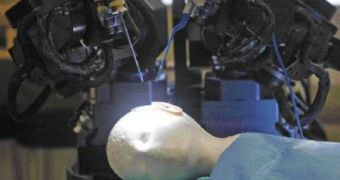Robots have a variety of industrial applications, where work is monotonous or potentially harmful to humans, or when human sense organs must be artificially enhanced.
In medicine, robotic surgery is the use of robots in performing surgery. Three major advances aided by surgical robots have been remote surgery, minimally invasive surgery, and unmanned surgery. Major potential advantages of robotic surgery are precision and miniaturization. Further advantages are articulation beyond normal manipulation and three-dimensional magnification. Some surgical robots are autonomous, and they are not always under the control of a surgeon.
They are only sometimes used as tools to extend the surgical skills of a trained surgeon, but now, they can mimic the surgeon's hands, even when he's not physically present.
Neurosurgeon Dr. Garnette Sutherland and his team, from University of Calgary Faculty of Medicine and the Calgary Health Region have spent the last six years leading a team of Canadian scientists, in cooperation with MacDonald, Dettwiler and Associates Ltd. (MDA), to design a machine "that represents a milestone in medical technology."
They developed a robot with a keen sense of touch that will let doctors perform microscopic operations on the brain using the most vivid visuals yet.
A melding of brain surgery and rocket science, the neuroArm allows neurosurgeons to do their riskiest work on patients within a magnetic resonance imaging machine, or MRI, giving a clear 3-D picture of even the smallest nerves.
It is scheduled to perform the first surgery at the site of the University of Calgary medical school's research facility.
The $24 million robot is expected to be used in its first operation this summer at Calgary's Foothills Hospital. "It will let doctors use surgical techniques on afflictions such as brain tumors that human surgeons are simply not dexterous enough to do", said Garnette Sutherland, a University of Calgary neurosurgeon who heads the project. "It is major step beyond the traditional view of just doctors and nurses operating on patients", he said.
The neuroArm is controlled from a cockpit-like room, where the surgeon grasps handles that let him feel pressure and texture, preventing blood vessels and other tissue from being squeezed too hard during operations.
Years of training and practice give surgeons the steadiest hands, but they can't match the neuroArm, which can be adjusted to take away any unwanted movement. "That stands to lengthen the careers of neurosurgeons, who naturally become shakier with age" Sutherland said.
The operator watches through a stereoscopic viewer, which provides depth perception, and can glance at a large MRI picture on a nearby computer screen. A doctor can even hear the robot work with microphones located near the surgical instruments. A touch-screen allows a 3-D graphic picture of the arms to be manipulated in any direction. "The goal of this is to make difficult surgeries easier, or impossible surgeries possible," robotics engineer Alex Greer said as he demonstrated the controls.
The long-term plan is to manufacture different versions of the neuroArm and sell them to other hospitals, although there is no detailed applications marketing plan in place yet.

 14 DAY TRIAL //
14 DAY TRIAL //